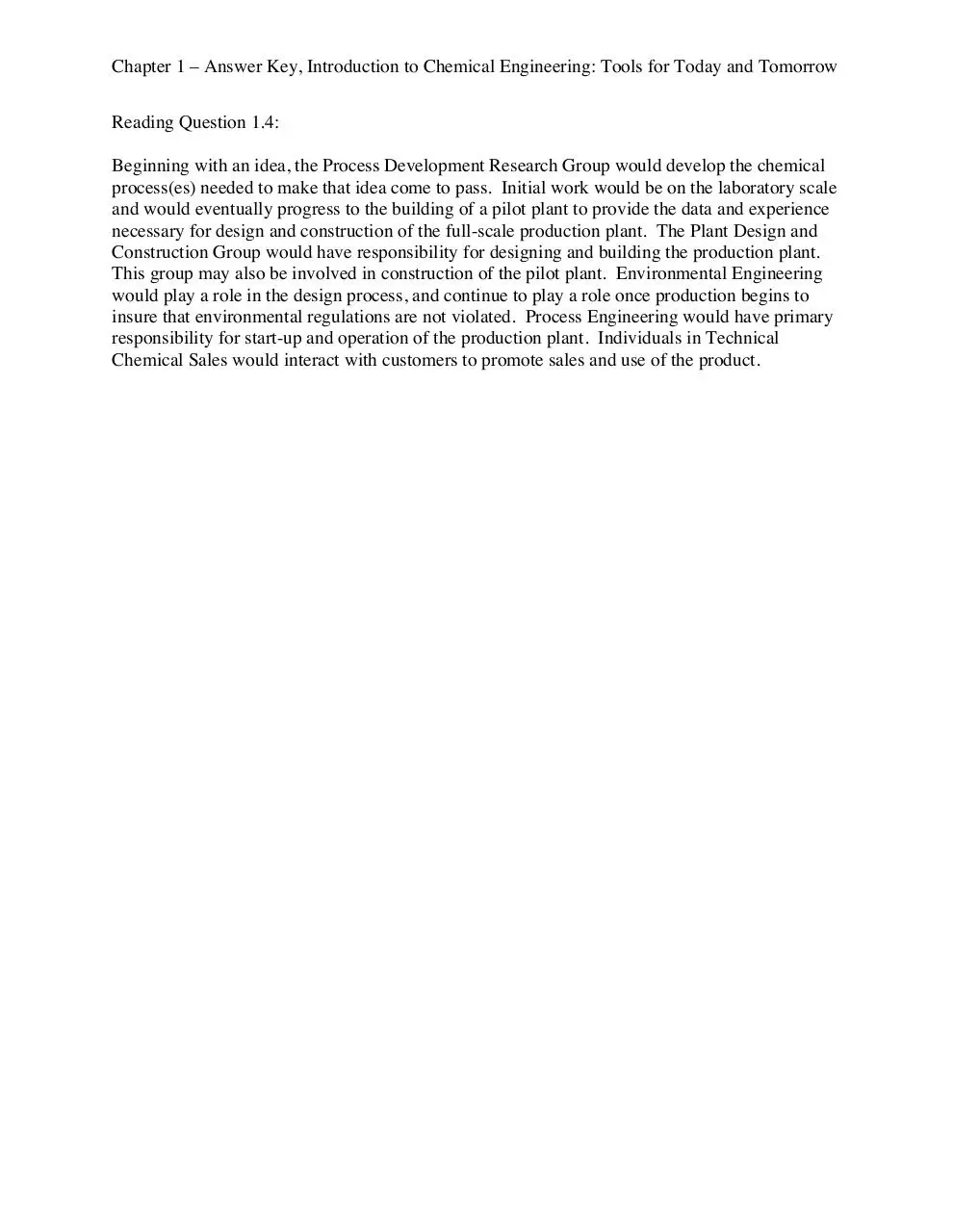introduction to chemical engineering ch (1) (PDF)
File information
Title: Chapter 1
Author: Ken Solen
This PDF 1.3 document has been generated by Microsoft Word / Mac OS X 10.6.4 Quartz PDFContext, and has been sent on pdf-archive.com on 21/02/2017 at 17:30, from IP address 47.197.x.x.
The current document download page has been viewed 644 times.
File size: 30.67 KB (5 pages).
Privacy: public file





File preview
Chapter 1 – Answer Key, Introduction to Chemical Engineering: Tools for Today and Tomorrow
Reading Question 1.1:
The three physical sciences used along with mathematics in chemical engineering are chemistry,
physics, and biology.
Chapter 1 – Answer Key, Introduction to Chemical Engineering: Tools for Today and Tomorrow
Reading Question 1.3:
The seven kinds of fundamental topics which chemical must learn about are: 1) Fluid Mechanics,
2) Heat Transfer, 3) Mass Transfer, 4) Reaction Engineering, 5) Process Control, 6) Materials
and Corrosion, and 7) Economics.
Chapter 1 – Answer Key, Introduction to Chemical Engineering: Tools for Today and Tomorrow
Reading Question 1.4:
Beginning with an idea, the Process Development Research Group would develop the chemical
process(es) needed to make that idea come to pass. Initial work would be on the laboratory scale
and would eventually progress to the building of a pilot plant to provide the data and experience
necessary for design and construction of the full-scale production plant. The Plant Design and
Construction Group would have responsibility for designing and building the production plant.
This group may also be involved in construction of the pilot plant. Environmental Engineering
would play a role in the design process, and continue to play a role once production begins to
insure that environmental regulations are not violated. Process Engineering would have primary
responsibility for start-up and operation of the production plant. Individuals in Technical
Chemical Sales would interact with customers to promote sales and use of the product.
Chapter 1 – Answer Key, Introduction to Chemical Engineering: Tools for Today and Tomorrow
Homework Problem 1.3:
Typical ingredients for soda drink or candy bar, deodorant, laundry detergent, and pain
medication should be listed. Obviously there will be differences due to different brands.
Chapter 1 – Answer Key, Introduction to Chemical Engineering: Tools for Today and Tomorrow
Homework Problem 1.4:
Many examples are possible. Here are a few possibilities:
Fluid mechanics: plumbing in your house.
Heat transfer: refrigerator, car radiator, furnace
Evaporation or drying: clothes dryer, hair dryer
Filtration: straining water out of food (e.g. spaghetti or vegetables)
Download introduction to chemical engineering ch (1)
introduction to chemical engineering ch (1).pdf (PDF, 30.67 KB)
Download PDF
Share this file on social networks
Link to this page
Permanent link
Use the permanent link to the download page to share your document on Facebook, Twitter, LinkedIn, or directly with a contact by e-Mail, Messenger, Whatsapp, Line..
Short link
Use the short link to share your document on Twitter or by text message (SMS)
HTML Code
Copy the following HTML code to share your document on a Website or Blog
QR Code to this page

This file has been shared publicly by a user of PDF Archive.
Document ID: 0000558100.